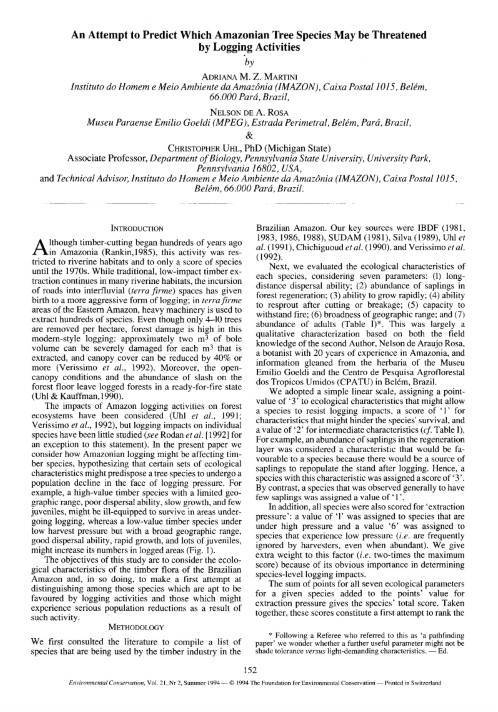

| Título | An Attempt to Predict Which Amazonian Tree Species May be Threatened by Logging Activities |
| Autores | Adriana M. Z. Martini (a) Nelson de A. Rosa (b) Christopher Uhl (c) |
| Vinculação dos autores | (a) Instituto do Homem e Meio Ambiente da Amazônia (Imazon) – Belém (PA), Brasil (b) Museu Paraense Emilio Goeldi (MPEG) – Belém (PA), Brasil (c) Department of Biology, Pennsylvania State University, University Park, Pennsylvania 16802, USA Instituto do Homem e Meio Ambiente da Amazônia (Imazon) – Belém (PA), Brasil |
| Ano de publicação | 1994 |
| Meio de publicação | Environmental Conservation (Volume 21, Issue 2, Summer 1994, pp. 152-162) |
| DOI (Digital Object Identifier) | https://doi.org/10.1017/S0376892900024589 |
The impacts of logging on Amazonian ecosystems has been the focus of considerable attention both within and outside of Amazonia. However, the impacts of logging on individual timber species has not been at all adequately investigated. Logging affects timber species by: (1) removing mature individuals that are important sources of seeds; (2) damaging seedlings and saplings (i.e future generations of canopy adults); and (3) creating conditions that favour fire by opening the canopy and leaving slash as fuel on the forest floor.
In this study we summarize information on the ecological characteristics of 305 timber species in Brazilian Amazonia. We identify seven ecological parameters that are useful in evaluating a species’ ability to resist the negative impacts of logging. These characteristics are: (1) effective long-distance dispersal ability; (2) abundance of saplings in forest regeneration; (3) rapid growth; (4) ability to resprout; (5) capacity to withstand fire; (6) broad geographic distribution; and (7) high density of adults. We hypothesize thai species with characteristics opposed to these parameters and subjected to intense logging pressure will have difficulty in maintaining their populations in logging regions.
We use a simple scoring system to rank species with regard to their hypothesized ability to withstand logging impacts. Among the species that are potentially susceptible to logging impacts are Euxylophora paraensis (‘Pau Amarelo’) and Swietenia macrophylla (American Mahogany). The sawn lumber from these two species goes principally to European and North American buyers, revealing a direct link between First World consumption and possible biodiversity impoverishment in the Brazilian rain-forest. These two species, and others that might experience population reductions as a result of logging, merit special study.
This post was published on 1 de junho de 1994
Título Índice de Progresso Social Brasil 2025 Autores Melissa Wilm Daniel Santos Beto Veríssimo Marcelo…
Amorim, L., Ferreira, R., Dias, M., Souza Jr., C., & Veríssimo, A. Sistema de Alerta…
Título Relatório Anual do Desmatamento no Brasil - RAD2024 Autores Carolina Del Lama Julia Shimbo…
Título Fatos da Amazônia 2025 Autores Daniel Santos Manuele Lima Agatha Vilhena Beto Veríssimo Caíque…
Amorim, L., Ferreira, R., Dias, M., Souza Jr., C., & Veríssimo, A. Sistema de Alerta…
Título A Vocação da Restauração Florestal na Amazônia com Base na Vegetação Secundária Autores Jayne…